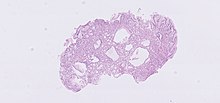Fundic gland polyposis
| Fundic gland polyposis | |
|---|---|
 | |
| Endoscopic image of fundic gland polyps taken on retroflexion of gastroscope. | |
| Specialty | Gastroenterology |
Fundic gland polyposis is a medical syndrome where the
Presentation
Most patients with fundic gland polyps (FGPs) do not have any symptoms, and the diagnosis is made on
- epigastricpain
- nausea
- vomiting
- weight loss
The polyps on endoscopy are usually tiny, numerous and
Disease associations
FGPs can be found in association with the following genetic conditions:[4]
- familial adenomatous polyposis|[6]
- attenuated familial adenomatous polyposis syndromes
- gastric adenocarcinoma associated with proximal polyposis of the stomach (GAPPS): this condition, described in three families[9] is characterized by development of antral adenomas and FGPs, with early development of severe dysplasia and gastric cancer, in absence of overt intestinal polyposis. This condition has been recently characterized by a point mutation in exon 1B of APC gene.[10]
Sporadic FGPs[1] have been associated with:
- chronic use of
- Helicobacter pylori infection: there is a reverse relationship between infection and fundic gland polyps, and infection by H pylori causes polyps regression.[15][16]
Pathophysiology

The development of polyps depends on the underlying disorder.[17] In sporadic cases of FGPs, more than 90% of patients have activating mutations in the β-catenin gene, so that they may be considered "neoplastic" polyps.[18]
In familial adenomatous polyposis, the abnormality is a mutation in the APC gene, resulting in its inactivity. Attenuated FAP can occur from other mutations in the APC gene, and causes a
Both the β-catenin gene and the APC gene are involved in the same cell growth signalling pathway, but the APC gene is known to have a significantly higher association with the development of colorectal tumors.[19]
Diagnosis
The most important consideration in evaluating patients with FGPs is distinguishing between sporadic form (patients without any other gastrointestinal condition, usually in middle age with female prevalence) and syndromic form. This is to ascertain the risk of development of
Screening
There is a risk of development of cancer with fundic gland polyposis,[22] but it varies based on the underlying cause of the polyposis.[4] The risk is highest with congenital polyposis syndromes, and is lowest in acquired causes.[4][23] As a result, it is recommended that patients with multiple fundic polyps have a colonoscopy to evaluate the colon.[4] If there are polyps seen on colonoscopy, genetic testing and testing of family members is recommended.[4] In the gastric adenocarcinoma associated with proximal polyposis of the stomach (GAPPS), there is a high risk of early development of proximal gastric adenocarcinoma.[9][10]
It is still unclear which patients would benefit with surveillance
Treatment
This section is empty. You can help by adding to it. (May 2022) |
References
- ^ PMID 16334981.
- S2CID 36152245.
- ^ PMID 10833897.
- ^ PMID 14598262.
- PMID 10685784.
- ^ "Familial Adenomatous Polyposis". The Lecturio Medical Concept Library. Retrieved 22 July 2021.
- PMID 10923933.
- PMID 10685627.
- ^ S2CID 206955098.
- ^ PMID 27087319.
- PMID 18322941.
- PMID 17285759.
- PMID 11710689.
- PMID 11505682.
- PMID 12377817.
- PMID 15479700.
- ^ "Gastric Cancer: Pathology and Genetics". ScienceDirect. Retrieved 22 July 2021.
- PMID 11238048.
- PMID 10982779.
- ^ "Gastric Cancer". The Lecturio Medical Concept Library. Retrieved 22 July 2021.
- ^ "Colon Cancer Treatment (PDQ®)". NCI. May 12, 2014. Archived from the original on July 5, 2014. Retrieved June 29, 2014.
- PMID 15131828.
- PMID 14560158.
- S2CID 24467292.
